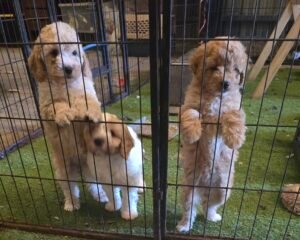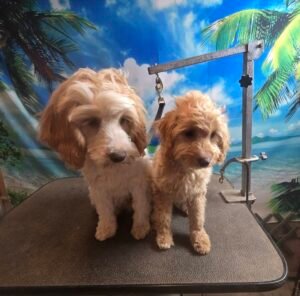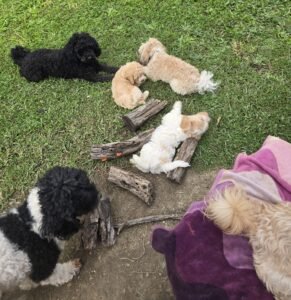Recently I commented on the use of Flooding as a technique used by dog groomers. It is apparent from the uproar that the post caused on a closed Facebook groomers group that the post hit a few nerves and it is also apparent that some groomers do not understand what flooding looks like. We are used to seeing a certain television personality fighting with red zone aggressive dogs until they “submit”. Experienced trainers and behaviorists agree that this is not a suitable technique to use in dogs unless it is totally a last resort and conducted by trainers highly experienced in its use..
I have shot some video to show what minor flooding looks like in a day to day grooming situation.
Meet River my noise phobic non-crate trained 3 yr old Belgian Shepherd farm dog. River was taken into the grooming salon on this day and forcibly pushed into the crate, which is a not an uncommon practice in pet establishments. This is a fairly common technique in grooming salons as many dogs fight when it comes to going into crates. Note not all salons use crates and of course mobile groomers rarely do. The video shows the result.
Here is the observation of the stress signs seen in this dog.
Rapid respiration in the absence of heat, tongue widened, lip lick, blinking, unable to settle, turning around, ears back, tense, sniffing, ears flicking around, sniffing, ears further back, lip licking, starts to look for way out, more ears back and moving, pacing, whale eye, lip licking, yawing, more lip licking, sniffing, still heavily panting, scanning area.
Groomer walks out of sight: starts worried barking, now groomer is back in area he won’t respond to hand, whale eye, ears back, asking for reassurance, whining, looking around, agitated. After 30 mins finally lying down ears still back, still panting but less tightness at mouth corner, ears held with less tension but still not really settled.
Here is the same dog but this time desensitization (DS) and counter conditioning (CC) are being used to set up a positive association with the crate. The door is kept open and the dog is free to go in and out as far as he feels comfortable. The pace at which he gets used to the crate is totally up to him. The dog will tell me when it is no longer fearful of the crate. In some dogs this can be minutes in others it may be a few short sessions.
Step 1: feeding at crate with open door. Dog won’t eat at first then eats from hand in vicinity of crate. Ears still back and somewhat unsettled, but ear posture further forward than in previous video, less panting.
Step 2: treats now put on floor near crate, dog scratches (stress) still unsettled, dog puts head in crate but refuses next time, won’t put more than head in crate, ears better. Body less tense, treats now into crate, dog allowed to go towards and away from create as often as he wants in his own time. Some stop to the panting from time to time. Food bowl put just inside crate and dog allowed to eat and leave.
Step 3: dog now enticed further into crate by treats and he goes right in and comes out no longer panting, ears forward engaged in game, does this a number of times. Groomer attempts to shut door slightly but makes a mistake and slams it – back track required as dog got frightened. Dog into and out of crate happily with door half shut. Dog happily eating and going in and out of crate with minimal stress. All food now coming in crate not from groomers hand. Speed he is being asked to go in and out increased. He starts to balk indicating he has taken enough for one session.
Further steps would be to increase the period of time the dog stayed in the crate and to gradually shut the door. At first the door would be shut only briefly and then immediately reopened working up to door being shut for longer and longer periods. This dog could initially only be left in the crate for short periods of time with a filled Kong to ensure it continues to have a positive association with the crate. This process could also be done at home by the dog’s owner.
A couple of days after this video was shot I came back to the salon after mobile grooming to find that River had actually gone into the crate to sleep while I was out. Clearly he now had a more positive association with it and no longer has to be physically forced into it. When the door is opened and I ask him to get in by a show of my hand he willingly walks in and lies down much more relaxed.
Here is the final video of River now happily walking and and out of the same crate without the use of treats.
I will continue to give him treats for a while yet however just to ensure that positive association remains as it is fragile in the early days with a dog that is in an alien environment such as the grooming salon is for a farm dog such as River.


Kareema
Healing Energy Animals
Kareema is the owners of Healing Energy Animals where devil dogs, horrible horses and crazy cats are turned into perfect pets using Relationship Animal Training and over 50 years of experience training a wide variety of animals.
Healing Energy Animals provides owners and pet professionals assistance with with common pet behavior training, feeding and grooming issues such as barking, escaping, scratching, aggression and fleas. Kareema consults and writes widely on a range of pet care issues for owners and also assists pet care professionals in setting up and growing their businesses by the provision of customer handling advice, sales and marketing strategies and up to date product information that allows for the differentiation of their pet care business from their competitors.
Healing Energy Animals is an Australian business but operates worldwide via the provision of virtual services.








